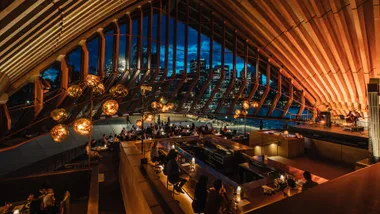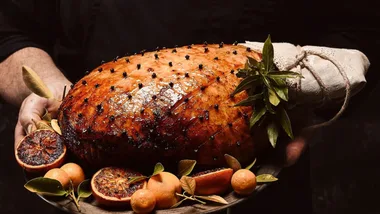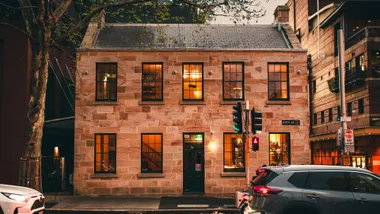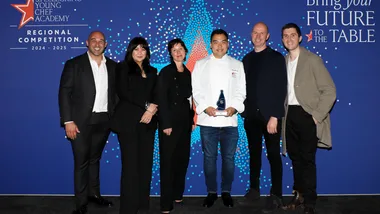It’s 6.50pm on a Tuesday and another 10 minutes until Sashimi Shinsengumi’s reservation line opens. For the last time, I scroll through the booking instructions on the Facebook page. A dedicated mobile number will be switched on for an hour. No texts. No call-backs. No waiting lists or dietary requirements. The post ends with a polite reminder that 42,000 people viewed the previous announcement. I close the page and hit dial.

Chef Shinji Matsui at Sashimi Shinsengumi (photography: Will Horner)
Sashimi Shinsengumi is a compact 12-seater in suburban Crows Nest and something of a holy grail for Sydney’s sushi obsessives. It’s here that chef Shinji Matsui and his wife, Tomoko, run a brisk Japanese takeaway by day and, three nights a week, serve an omakase, or chef’s choice, of 20-odd dishes for an improbable $80.
A night here might start with a briny oyster in ponzu sauce and a morsel of char-grilled garfish, before a march of just-made nigiri – some draped in plump, freshly shelled scampi, others with seared kingfish belly or saltwater eel in a sticky soy glaze. No matter what the line-up, by the time the tamagoyaki arrives, the traditional final course, served here warm and custardy in its cast-iron pan, you’ll have been taken through the day’s best catch.

Nigiri at Sokyo (photography: Will Horner)
Omakase is short for omakase shimasu, which roughly translates to “I’ll leave it to you”. It comes from the Japanese word makaseru, or “to entrust”. Think of it as a dégustation that usually features up to 20 pieces of individually served nigiri and can last two or more hours. While the line-up may include appetisers, a soup or a dessert, in general it’s a deep dive into the bright, clean flavours of raw fish.
“Omakase is a true test of how good the sushi chef is,” says sushi enthusiast Dan Hong, chef at Mr Wong. “It’s all about their rice, how it’s seasoned, how it’s put together, and what touches they can add to the sushi to make it their own.”
On Instagram, Hong often shares omakase dispatches with his 53,800 followers. When Sokyo launched its sushi tasting menu in 2014, he was one of the first to share pictures of chef Takashi Sano’s expertly crafted sushi – sparking massive social-media interest that soon led to long queues at the restaurant.
Despite being a city by the ocean, Sydney has a glaring lack of refined sushiya. We may have enviable access to wild-caught fish such as snapper and trevally and sea urchin that rivals the quality of Hokkaido uni, but it hasn’t yet translated into world-class sushi.
“The quality of Sydney’s sushi compared with overseas is not great,” says Hong. “What we do have – like Sano-san’s sushi – is very good. But there’s not enough of it. If you look at Asia and New York, there are so many upscale sushi places. But here, there aren’t many high-profile omakase restaurants except for Minamishima in Melbourne.”
Could it be that the majority of the dining public still think of sushi as a fast-casual food? “There’s so much mediocre stuff around and everyone seems to be okay with it,” says Sokyo chef Chase Kojima. “Who’s going to pay $80 for sushi when you can eat so much for less?”
The few ambitious mid-price restaurants that serve traditional omakase end up doing so as an off-menu offering for discerning fans and regulars, driving the fine-dining sushi scene underground.

Fishmonger Narito Ishii (photography: Will Horner/Sydney Fish Market)
“In Sydney, you have to know exactly where to go to get good sushi,” says Narito Ishii, a Kyushu-born fishmonger at Pyrmont Seafood who supplies fish to the city’s top Japanese restaurants. “For me, it’s important that I know the person. Because sushi is made by hand – it’s a personal experience. You can usually tell when you sit down and talk to the chef that ‘this guy will look after me’.”
Ishii has been in the seafood-supply business for the past 20 years. I meet him on a hot afternoon at the Sydney Fish Market, where every third person seems to stop to say hello or have a quick banter with him.
“Every morning, there are 10 or 12 people on my phone that I text about what fish are available in the market,” he says. The text goes out at 5.30am, before the auction. In Sydney, five chefs’ names tend to come up time and again in the omakase scene. All five source their fish from Ishii. Together, they form a rarefied circle of craftsmen, each with a loyal fan base for their particular take on sushi.
In the social media stakes, Matsui wins the ultimate bragging rights, his no-frills, generously topped nigiri at Sashimi Shinsengumi frequently going viral. Then there’s Masuya restaurant’s Toshihiko Oe – Ishii’s go-to sushi master – who offers a traditional, handwritten omakase menu to regulars.

Chef Matsui (photography: Maikeru Nirvana)
Back across the bridge, former Azuma chef Tomoyuki Matsuya is known for his delicately seasoned, shiso-heavy line-up. And making a comeback to the omakase world is sushi master Ryuichi Yoshii, former head chef of Yoshii, who offers a tasting menu of 15-odd courses at his new Barangaroo fine-diner, Fujisaki.
And there’s no shortage of devotees vying to get a spot in front of chef Sano at the Sokyo sushi bar. He apprenticed under Matsui before becoming the private sushi chef to Tetsuya Wakuda at Tetsuya’s. He now oversees one of the most ambitious, radically modern omakase menus in Sydney.
“Last September, I booked a table at Sokyo for January. In November, I booked for May,” says omakase aficionado and blogger Michael Shen. “You’re literally planning it so far ahead it’s like a holiday.”
Shen has had the Sokyo omakase 11 times to date. Chef Kojima attributes this loyalty squarely to Sano’s skills.

Nigiri at Sokyo (photography: Will Horner)
“In New York, Singapore, Hong Kong you can get fish straight from Japan,” says Kojima. “We can’t win against Japanese fish, but Sano-san will cut it or marinate it a certain way that makes it melt in your mouth.”
To see Sano at work is a big part of the appeal – the edge of his knife barely dances above a piece of kama-toro tuna cheek on the pull stroke, scoring it 40 times without mincing the fish. Or hearing him talk about fish-ageing techniques, explaining why a side of marlin takes two months to age, or a blue-fin tuna just two weeks. All that work – all that ageing, coaxing, scoring, and in one bite it’s gone.
To make omakase-level sushi, you need the best cut of the best fish. Right now, a spot at Sano’s chef’s table will set you back $165 – a price tag that’s not much above cost.
“If we were to make money, to survive, we should be charging at least $300 per person,” says Kojima. “At first, I thought it would be a cool thing to have the most expensive dégustation menu in the country. And then I thought, forget making money. Because charging so much will make us cocky. We don’t want to make sushi just for rich people. I’m not rich. Sano’s not rich. I want to be on that team.”
But with restaurants like Sokyo and Fujisaki raising the local profile of omakase, perhaps there’s no reason why we can’t one day elevate the value of fine-dining sushi. “People would pay that much for VIP concert tickets,” says Shen. “This is just my kind of performance.”
After failing to get a spot at Sashimi Shinsengumi, I pick up the phone to order a consolation prize – Matsui’s sushi platter. When I get through, however, I find myself doing what the reservation post says not to do: airing my grievances. Matsui listens with practised patience. “Will you give me a call if anyone cancels?” I ask. Before I can leave my name, he asks, “You’re Candice, right?” With an eye to future regulars, he’s saved my details from the time I got a table last year. “I’ll call you,” he says.
WHERE TO FIND SYDNEY’S BEST SUSHI
AZUMA
Cost $120. Book Call. The queue Five days. The meal 14 courses, including 10 pieces of sushi Contact Level 1, 2 Chifley Sq, Sydney, (02) 9235 2717, azuma.com.au
HANA JU-RIN
Cost $132. Book Call. The queue A week. The meal 21 courses, including 15 pieces of sushi. Contact Shop 1, 300 Pacific Hwy, Crows Nest, (02) 9966 5833, jurin.com.au
FUJISAKI
Cost $160. Book Via website. The queue A week. The meal 20-22 courses, including about 19 pieces of sushi. Contact Shop 2, 100 Barangaroo Ave, Sydney, (02) 9052 9188, lotusdining.com.au
KABUKI SHOROKU
Cost From $120. Book Call. The queue Three days. The meal 14-16 courses. Contact 31 Market St, Sydney, (02) 9267 4552, kabukishoroku.com.au
MASUYA
Cost $120 Book Call. The queue At least two weeks. The meal 21 courses, including 11 pieces of sushi. Contact Basement, 12-14 O’Connell St, Sydney, (02) 9235 2717, masuyainternational.com.au
FOR ADVANCED SUSHI NERDS
SASHIMI SHINSENGUMI
Cost $80. Book Follow on Facebook and look out for bimonthly booking instructions. The queue Months; it’s a challenge. The meal 20 courses, including 15 pieces of sushi. Contact Shop 5, 7-11 Clarke St, Crows Nest, facebook.com/SashimiShinsengumi
SOKYO AT THE STAR
Cost $165. Book Look for Sokyo announcements on Instagram, then book via the website. The queue Six months. The meal 26 courses, including 16 pieces of sushi. Contact Level G, The Darling, The Star, 80 Pyrmont St, Pyrmont, (02) 9657 9161, star.com.au









